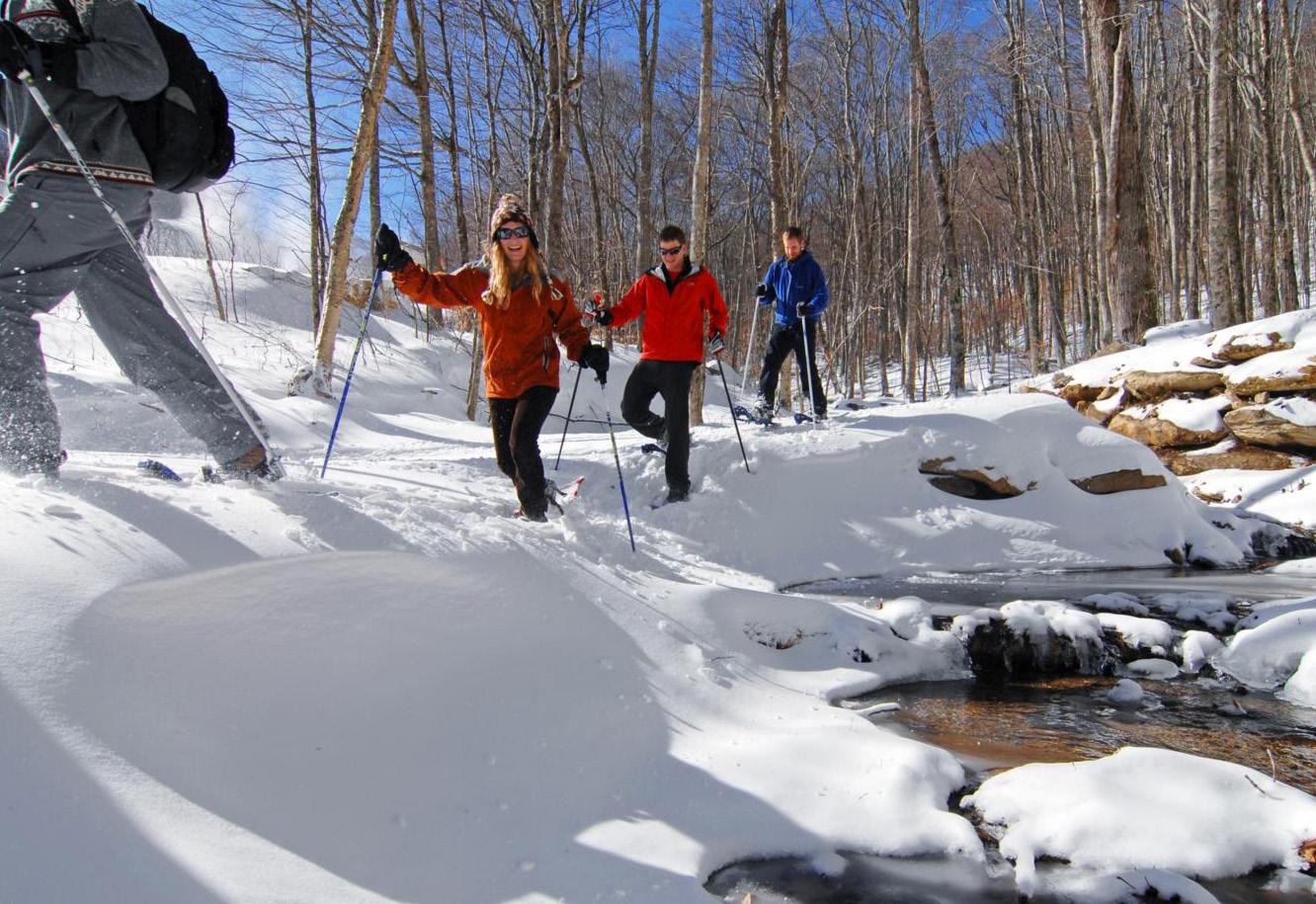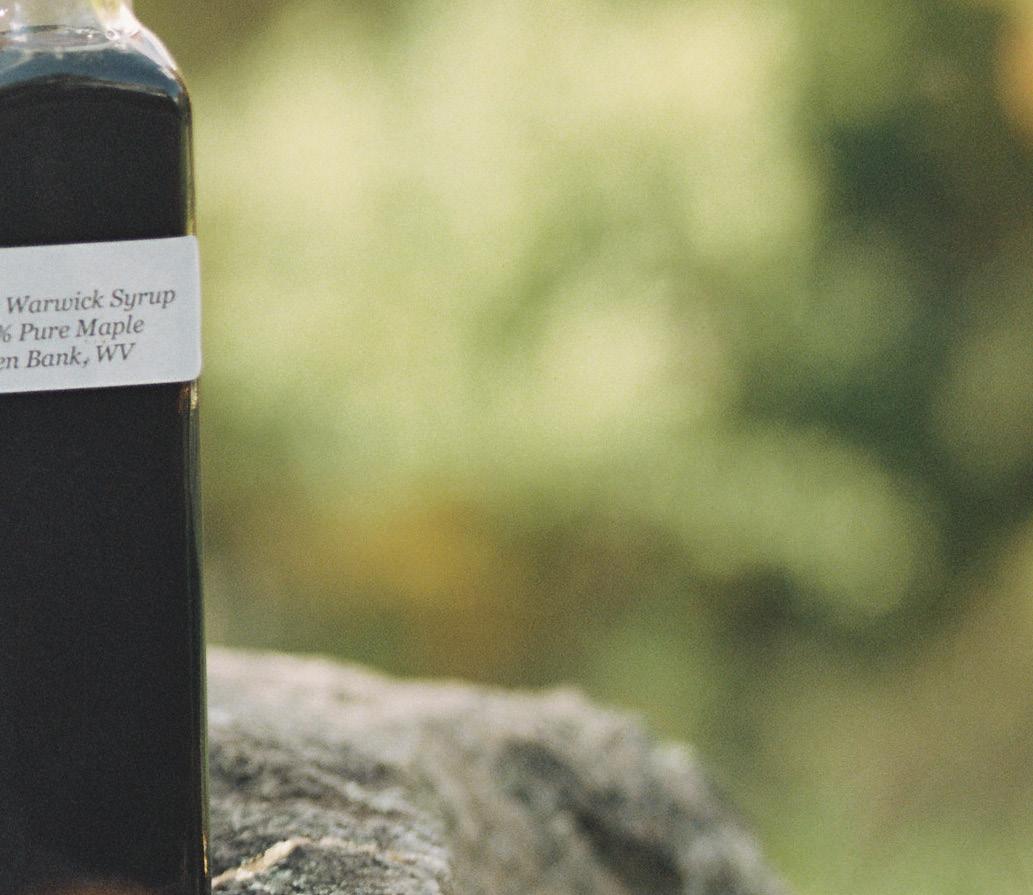
5 minute read
WALK ON THE SNOW
Snowshoeing the South
Three Spots for Making Tracks in the Mountains
BY NOAH POULOS
I HAVE NO FONDER WINTER MEMORY THAN
summiting the frozen top of Mount Mansfield with my wife outside of Burlington, Vermont, one cold February. Snow-covered spruce trees, solid frozen creeks, and icy gusts painted the mood of that day. The ground, covered in two feet of snow, could not have been traversed without my trusty snowshoes. Strapped and ready, we pushed through the powder and made it to the top of the tallest mountain in the state in a matter of hours, rewarded with a joyful butt-slide down the entire mountain to where we began.
It was a wintery adventure for the ages and when I returned home to western North Carolina, I thought “Why the heck don’t I do this where I live?” In my search, I realized that Southern Appalachia is home to some truly incredible places to explore via snowshoe in the coldest months of winter. Though a two-foot snowfall is rarer here than farther north, there are some prime spots in the region to explore with snowshoes when the conditions are right.
Few places are as splendid to wander in the winter than the icy, snowpacked Blue Ridge Parkway. The scenic road has many closures during the winter, but these only exclude motor vehicles. Hikers, crosscountry skiers, and snowshoers may enter and explore no matter the depth of snow.
Over the years I have trekked near my home across the Craggy and Black Mountain ranges in the dead of winter and found pure solitude. The only signs of life along the road were the bobcat and coyote tracks I followed from Bull Gap high up into the mountains near Asheville. Along the road, which goes from Rockfish Gap, Va., 469 miles to Cherokee, N.C., there are countless trails that spur off, allowing winter adventurers to take smaller wooded paths. Along such trails I’ve encountered frozen waterfalls, massive ice sheets, and five foot icicles.
The parkway is just a day's drive or less for many people across the region. However, it is important to locate the access points to high elevation areas, since these tend to be the places where the snow falls and sticks. The Blue Ridge Parkway has a handy interactive map (blueridgeparkway.org/parkway-map/) that allows visitors to see the access points and road closures year-round.
Great Smoky Mountains National Park: North Carolina/Tennessee (Intermediate)
Anyone who has spent time in the Smokies knows their glory. While most visitors come in the spring, summer, and autumn, winter is a uniquely beautiful time to hit the park. Tourists are few, many roads and trails are closed, and for several months the most visited National Park in the country is a place where one can find solitude.
Clingmans Road, which leads to breathtaking views of the park and surrounding mountains, is closed through the winter, making for a wide path to navigate via snowshoe. Like the parkway, there are multiple trails that spur off from the road, including the Appalachian Trail. If there is sufficient snowpack, you can snowshoe the crest of the Smokies and see some of the most epic parts of the park in their wintery state.
Newfound Gap Road is typically kept plowed through the winter all the way up to the parking lot, making cold-season access easy. If there is fresh snow and Newfound Gap Road is closed temporarily, it’s a prime spot to whip out the snowshoes and hike up the mountain.
As with any of these spots, it is important to keep an eye on the weather and make sure that there is ample snow before setting out on this type of trek. This is made particularly easy when heading to Newfound Gap, as the park has a camera that takes live shots every 15 minutes and posts them to air-resource.net/ grsmnfgap/. Cranberry Wilderness: West Virginia (Advanced)
In southeastern West Virginia lies a massive and remote wildland called the Cranberry Wilderness. This nearly 50,000-acre forest has an elevation profile ranging from 2,400 to 4,600 feet. Anywhere above 3,000 feet can get regular snows throughout the winter, and this off-the-beaten-track setting makes for a perfect overnight snowshoeing getaway. There are many loops in the wilderness that range in length from 10 to 30 miles, giving winter backpackers the perfect routes to plan overnight trips.
Because it is a vast wilderness, some trails in the Cranberry are overgrown and markers can be hard to spot in the snow, so some map reading and orienteering skills will likely be required. Additionally, it is crucial to bring a vehicle that can handle winter conditions, as Highway 150, the main access road to hiking trails, is not maintained during winter. Though challenging, with proper planning this is a great place for experienced snowshoers to find some solitude.
SUGAR MOUNTAIN SKI RESORT IN NORTH CAROLINA OFFERS GUIDED SNOWSHOEING TRIPS. PHOTO COURTESY OF EXPLORE BOONE
Resort Snowshoeing
Many ski resorts in the Blue Ridge have designated trails for snowshoeing. Canaan Valley Resort in the Allegheny Mountains of West Virginia holds 35 kilometers of marked and ungroomed trails for snowshoeing and cross-country skiing, while Sugar Mountain Resort offers one-hour guided snowshoeing tours on its vast acreage in the North Carolina High Country.





The beginning of endless discovery.
Pocahontas County is a true vacation destination with its surreal beauty and charming mountain towns. This season, immerse yourself in the local scene and savor one of the sweetest experiences during the Mountain State Maple Days on February 18 and March 18. Explore maple farms with experiential tours, educational activities, product samples and more.
WVtourism.com/PocahontasCounty















